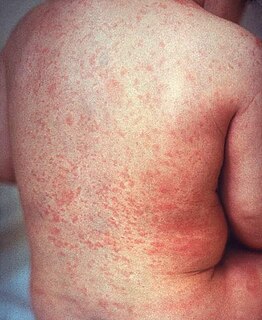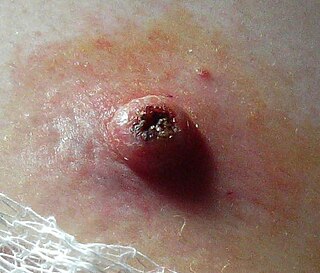Related Research Articles

Rubella, also known as German measles or three-day measles, is an infection caused by the rubella virus. This disease is often mild with half of people not realizing that they are infected. A rash may start around two weeks after exposure and last for three days. It usually starts on the face and spreads to the rest of the body. The rash is sometimes itchy and is not as bright as that of measles. Swollen lymph nodes are common and may last a few weeks. A fever, sore throat, and fatigue may also occur. Joint pain is common in adults. Complications may include bleeding problems, testicular swelling, encephalitis, and inflammation of nerves. Infection during early pregnancy may result in a miscarriage or a child born with congenital rubella syndrome (CRS). Symptoms of CRS manifest as problems with the eyes such as cataracts, deafness, as well as affecting the heart and brain. Problems are rare after the 20th week of pregnancy.

Roseola, also known as sixth disease, is an infectious disease caused by certain types of virus. Most infections occur before the age of three. Symptoms vary from absent to the classic presentation of a fever of rapid onset followed by a rash. The fever generally lasts for three to five days, while the rash is generally pink and lasts for less than three days. Complications may include febrile seizures, with serious complications being rare.

Erythema infectiosum or fifth disease is one of several possible manifestations of infection by parvovirus B19.

A plantar wart, or verruca, is a wart occurring on the bottom of the foot or toes. Its color is typically similar to that of the skin. Small black dots often occur on the surface. One or more may occur in an area. They may result in pain with pressure such that walking is difficult.

Cellulitis is a bacterial infection involving the inner layers of the skin. It specifically affects the dermis and subcutaneous fat. Signs and symptoms include an area of redness which increases in size over a few days. The borders of the area of redness are generally not sharp and the skin may be swollen. While the redness often turns white when pressure is applied, this is not always the case. The area of infection is usually painful. Lymphatic vessels may occasionally be involved, and the person may have a fever and feel tired.

Lichen planus (LP) is a chronic inflammatory and immune-mediated disease that affects the skin, nails, hair, and mucous membranes. It is not an actual lichen, and is only named that because it looks like one. It is characterized by polygonal, flat-topped, violaceous papules and plaques with overlying, reticulated, fine white scale, commonly affecting dorsal hands, flexural wrists and forearms, trunk, anterior lower legs and oral mucosa. Although there is a broad clinical range of LP manifestations, the skin and oral cavity remain as the major sites of involvement. The cause is unknown, but it is thought to be the result of an autoimmune process with an unknown initial trigger. There is no cure, but many different medications and procedures have been used in efforts to control the symptoms.

Pityriasis rosea is a type of skin rash. Classically, it begins with a single red and slightly scaly area known as a "herald patch". This is then followed, days to weeks later, by a rash of many similar but smaller round or oval lesions, mainly on the trunk and upper limbs. About 20% of cases show atypical deviations from this pattern. It usually lasts less than three months and goes away without treatment. Sometimes malaise or a fever may occur before the start of the rash or itchiness, but often there are few other symptoms.

Staphylococcal scalded skin syndrome (SSSS) is a dermatological condition caused by Staphylococcus aureus.

A spider angioma or spider naevus, also nevus araneus, is a type of telangiectasis found slightly beneath the skin surface, often containing a central red spot and deep reddish extensions which radiate outwards like a spider's web or a spider's legs. They are common and often benign, presenting in around 10–15% of healthy adults and young children. However, having more than three spider angiomas is likely to be abnormal and may be a sign of liver disease; it also suggests the probability of esophageal varices.

Keratoacanthoma (KA) is a common low-grade rapidly-growing skin tumour that is believed to originate from the hair follicle and can resemble squamous cell carcinoma.

Morphea, is a form of scleroderma that involves isolated patches of hardened skin on the face, hands, and feet, or anywhere else on the body, with no internal organ involvement.

Heinrich Koebner ; was a German-Jewish dermatologist born in Breslau.

Chickenpox, also known as varicella, is a highly contagious disease caused by the initial infection with varicella zoster virus (VZV). The disease results in a characteristic skin rash that forms small, itchy blisters, which eventually scab over. It usually starts on the chest, back, and face. It then spreads to the rest of the body. Other symptoms may include fever, tiredness, and headaches. Symptoms usually last five to seven days. Complications may occasionally include pneumonia, inflammation of the brain, and bacterial skin infections. The disease is often more severe in adults than in children. The incubation period is 10–21 days, 14–16 days, after which, a characteristic rash appears.
Gianotti–Crosti syndrome, also known as infantile papular acrodermatitis, papular acrodermatitis of childhood, and papulovesicular acrolocated syndrome, is a reaction of the skin to a viral infection. Hepatitis B virus and Epstein–Barr virus are the most frequently reported pathogens. Other viruses implicated are hepatitis A virus, hepatitis C virus, cytomegalovirus, coxsackievirus, adenovirus, enterovirus, rotavirus, rubella virus, HIV, and parainfluenza virus.

Cutaneous small-vessel vasculitis (CSVV), also known as hypersensitivity vasculitis, cutaneous leukocytoclastic vasculitis, hypersensitivity angiitis, cutaneous leukocytoclastic angiitis, cutaneous necrotizing vasculitis and cutaneous necrotizing venulitis, is inflammation of small blood vessels, characterized by palpable purpura. It is the most common vasculitis seen in clinical practice.
Cobb syndrome is a rare congenital disorder characterized by visible skin lesions with underlying spinal angiomas or arteriovenous malformations (AVMs). The skin lesions of Cobb syndrome typically are present as port wine stains or angiomas, but reports exist of angiokeratomas, angiolipomas, and lymphangioma circumscriptum. The intraspinal lesions may be angiomas or AVMs and occur at levels of the spinal cord corresponding to the affected skin dermatomes. They may in turn produce spinal cord dysfunction and weakness or paralysis.
Eruptive pseudoangiomatosis is a cutaneous condition characterized by the sudden appearance of 2- to 4-mm blanchable red papules.
Asymmetric periflexural exanthem of childhood (APEC) is a rare, self-limited and spontaneously resolving skin rash of the exanthem type with unknown cause that occurs in children. It occurs primarily in the late winter and early spring, most common in Europe, and affecting girls more often than boys.
Idiopathic scrotal calcinosis is a cutaneous condition characterized by calcification of the skin resulting from the deposition of calcium and phosphorus occurring on the scrotum. However, the levels of calcium and phosphate in the blood are normal. Idiopathic scrotal calcinosis typically affects young males, with an onset between adolescence and early adulthood. The scrotal calcinosis appears, without any symptoms, as yellowish nodules that range in size from 1 mm to several centimeters.
Skin and skin structure infections (SSSIs), also referred to as skin and soft tissue infections (SSTIs), or acute bacterial skin and skin structure infections (ABSSSIs), are infections of skin and associated soft tissues. Historically, the pathogen involved has most frequently been a bacterial species—always, since redescription of SSSIs as ABSSSIs—and as such, these infections require treatment by antibiotics.
References
- 1 2 Neva, Franklin A. (May 3, 1956). "A second outbreak of Boston Exanthem Disease in Pittsburgh during 1954". New England Journal of Medicine. 254 (18): 838–843. doi:10.1056/nejm195605032541806. PMID 13309687.
- ↑ James, William D.; Berger, Timothy G.; et al. (2006). Andrews' Diseases of the Skin: clinical Dermatology. Saunders Elsevier. ISBN 0-7216-2921-0.
- 1 2 Neva, Franklin A.; Feemster, Roy F.; Gorbach, Ilse J. (June 5, 1954). "Clinical and epidemiological features of an unusual epidemic exanthem". JAMA. 155 (6): 544–548. doi:10.1001/jama.1954.03690240010004. PMID 13162750.
- ↑ Rebora, Alfredo (2005). "Life-threatening cutaneous viral diseases". Clinics in Dermatology. 23 (2): 157–163. doi:10.1016/j.clindermatol.2004.06.020. PMID 15802209.